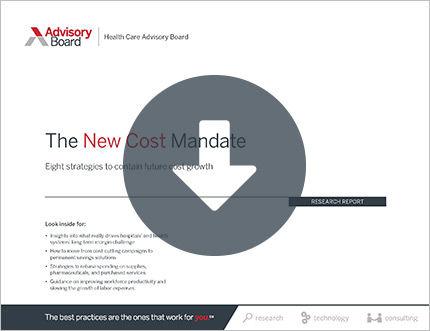Read Advisory Board's take on this story.
A new accounting standard significantly restricts what hospitals may report as bad debt—and it could affect how hospitals report their community benefits, according to some experts, Tara Bannow writes for Modern Healthcare.
Upcoming webconference: Learn how to deliver a best-in-class patient financial experience
According to Bannow, most large health systems are required to apply the new standard—called the Revenue from Contracts with Customers, or Topic 606—for annual reporting that started after Dec. 15, 2017. For most other health systems, the standard will take effect after Dec. 15, 2018.
Details on the new accounting standard
Under the old standard, some hospitals reported bad debt as the difference between the amount they billed their patients and the amount their patients ended up actually paying—even in instances when the hospital never expected to receive the entire amount billed.
Under the new standard, hospitals are permitted to report bad debt only in instances when an adverse event, such as bankruptcy or loss of employment, prevents a patient from paying what the hospital, based on historical experience, expected to receive.
For example, Bannow explains that a hospital that if a hospital charged an uninsured patient $100 and received only $10, it could not—under the new standard—report any bad debt if it had expected to receive only $10. Further, if the patient did not pay the $10, hospitals under the new standard would only be able to report the difference as bad debt if the cause was an unexpected adverse event, Bannow writes.
Concerns about the change
Some experts are concerned that the change will affect how hospitals report their community benefits, Bannow writes. While the IRS doesn't include bad debt in its formal definition of community benefits, some hospitals include bad debt in larger categorizations such as charity care and Medicaid or Medicare shortfalls.
There's also a concern that the change will affect hospitals' justification for tax-exempt status, experts said, since bad debt—which tax-exempt hospitals report on their IRS Form 990—is an important measure for maintaining that status, Bannow reports.
However, Rick Kes, an audit senior manager at RSM US, said he believes many hospitals may sidestep the change by simply swapping out the term "bad debt" with "implicit price concession"—a term that largely means the same thing.
"[Implicit price concession] isn't a required disclosure," Kes said, "but we believe not-for-profit health systems will want to disclose that number in their footnotes of financial statements so that they could then use that number for their community benefit reporting" (Bannow, Modern Healthcare, 3/17).
Advisory Board's take

Robin Brand, Senior Director
These changes will not only bring added complexity to health system accounting and financial reporting—they also could potentially impact patient collection practices and revenue cycle performance measurement.
As Modern Healthcare noted, under the new standards, health systems can report only unpaid amounts as bad debt if an adverse event prevented the patient from paying in full. Health systems may instead start reporting "implicit price discounts" (or "implicit price concession"), which would include what was traditionally categorized as bad debt.
Here's the catch, though: Unpaid revenue can be reported as implicit price discounts only if the hospital continues to care for the patient without performing a credit assessment or any other type of analysis of the patient's likelihood to pay. We've seen many of our member organizations adopt credit assessments and likelihood-to-pay analyses in direct response to the increase in patient deductibles and greater attention being paid to patient collections.
In fact, propensity-to-pay scoring specifically has come to define best practice. Many organizations use these scores to prioritize patient collection efforts and to determine whether financial counseling, payment plans, or other types of financial services should be offered to the patients in question. The fact that using these scores would prevent organizations from categorizing unpaid amounts as implicit price discounts could give health systems pause about using propensity-to-pay scores, which in turn could make patient collections more difficult.
Another complication of these changes is that organizations may need to track implicit price discounts if they do not already do so. Having a new metric to monitor can be burdensome, but there's also an upside: Narrowing the bad debt definition should make comparisons between organizations easier and provide a more accurate picture of hospital financial health. Currently, we see quite a bit of variation in how health systems define their bad debt.
Next, learn how to deliver a best-in-class patient financial experience
Join us for a webconference on May 9 to learn how to transform your revenue cycle to meet your patients' financial expectations, increase revenue, and maintain loyalty. Secure your spot for the webconference today.
Register NowHow to jump-start your revenue cycle performance
We've helped hundreds of hospitals and medical groups with their revenue cycle issues—experience we can deploy to solve your organization's unique challenge. Contact our experts for help with your revenue cycle issues.
Get in Touch With Our ExpertsDon't miss out on the latest Advisory Board insights
Create your free account to access 2 resources each month, including the latest research and webinars.
Want access without creating an account?
You have 2 free members-only resources remaining this month remaining this month.
1 free members-only resources remaining this month
1 free members-only resources remaining this month
You've reached your limit of free monthly insights
Become a member to access all of Advisory Board's resources, events, and experts
Never miss out on the latest innovative health care content tailored to you.
Benefits include:
You've reached your limit of free monthly insights


